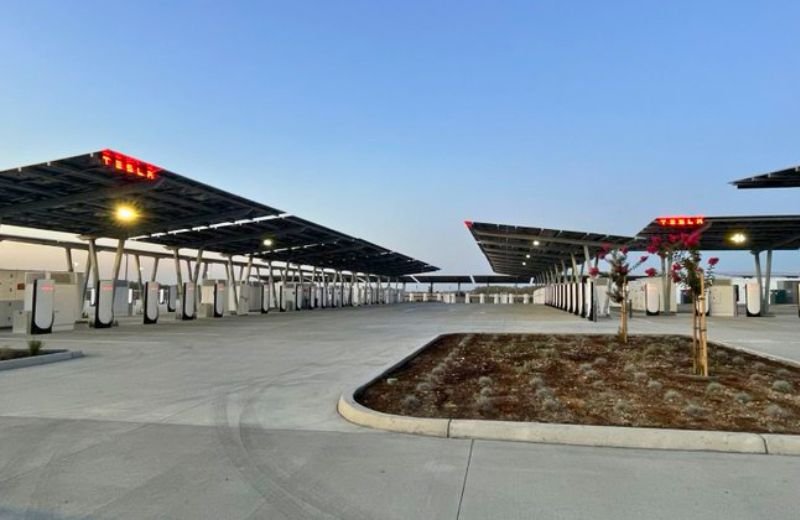The new solar powered supercharger built by Tesla is creating a huge moment in the world of electric vehicles. As conversations continue about future energy demands and the pressure on the grid, Tesla has introduced a station that shows how powerful renewable energy can be when scaled the right way. Their newest site in Lost Hills California is now the largest Supercharger station ever made, and it is almost entirely powered by sunshine.
A New Milestone In Sustainable EV Charging
Tesla’s Lost Hills Supercharger site features an impressive 164 stalls, making it the biggest charging station the company has ever developed. What makes it even more remarkable is the massive 11 megawatts of solar panels installed above the parking area. These panels also act as a canopy to protect vehicles from direct heat, creating a more comfortable charging experience for drivers.
All that solar energy is stored in ten Tesla Megapack batteries, giving the station a combined capacity of 39 megawatt hours. That storage system allows Tesla to run the location using clean energy even when the sun goes down. For comparison, most fast charging sites in the United States offer only four to twenty stalls. Tesla already had a huge 120 stall site in Barstow, but Lost Hills has now taken the top spot.

The company says that building the station this way gave them a major advantage. A traditional grid connection can take many months or sometimes years to complete because utilities need time to upgrade infrastructure. By relying on its own solar generation and Megapacks, Tesla avoided long delays and brought the station online faster. It took just eight months to open the first 84 stalls and around one year to complete the entire site.
Why This Matters For The Future Of Charging
This new solar powered supercharger is more than a massive project. It is a sign of where the industry is heading. Using solar energy and large scale batteries helps solve one of the biggest challenges in EV expansion which is the slow pace of grid upgrades. Many companies are now studying similar models to speed up installations.
Other players are also moving in this direction. BYD has mentioned that future megawatt level charging will likely need batteries on site to support the power load. A Seattle based company, Electric Era, recently installed a charging station in only 54 days using on site storage. As more renewable energy systems become available and as battery supply increases in the US, these hybrid charging models are becoming easier to build.
Also Read CCD Gets Rs 1 Billion Fleet of Land Cruisers and Pickups

Tesla’s vertical integration also plays a major role. The same company that builds the cars also designs the chargers and manufactures energy storage systems. This gives Tesla the ability to handle everything in the process, from generation to storage to charging. That kind of efficiency is becoming a major trend across the automotive world.
The Lost Hills station is not technically fully off grid but it is very close. Tesla confirmed that there is a small utility connection meant mostly for future expansion. However, the daily operation of the station is powered almost entirely by sunlight. On most days of the year the energy used by vehicles will come directly from the solar canopy and the Megapacks.
A Model For What Future Charging Could Look Like
This development shows how renewable energy and EV infrastructure can work together at a large scale. The combination of solar power, battery storage and fast chargers creates a blueprint for a cleaner and more reliable charging network. As demand for electric vehicles continues to change and as energy concerns rise, stations like this will help support smoother growth.

Drivers who visit the Lost Hills location will experience what the future of charging might look like in more places across the country. Faster installations, cleaner energy and more control over the power supply can help solve many of the challenges that currently slow down EV adoption.
Tesla’s solar powered supercharger at Lost Hills is a major milestone. It is a practical example of what sustainable charging can achieve and how renewable energy can support large scale transportation. As more companies choose similar solutions and more communities push for cleaner infrastructure, this approach may soon become the standard. The future of charging looks brighter with this powerful solar powered supercharger leading the way.






